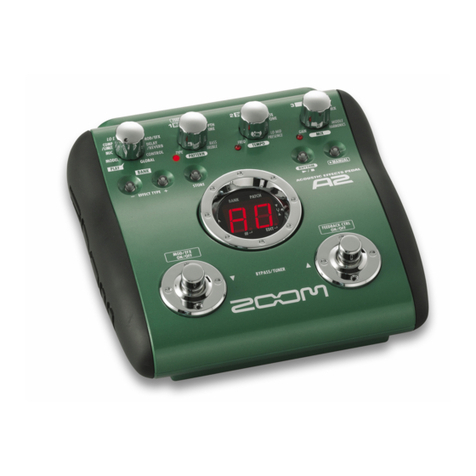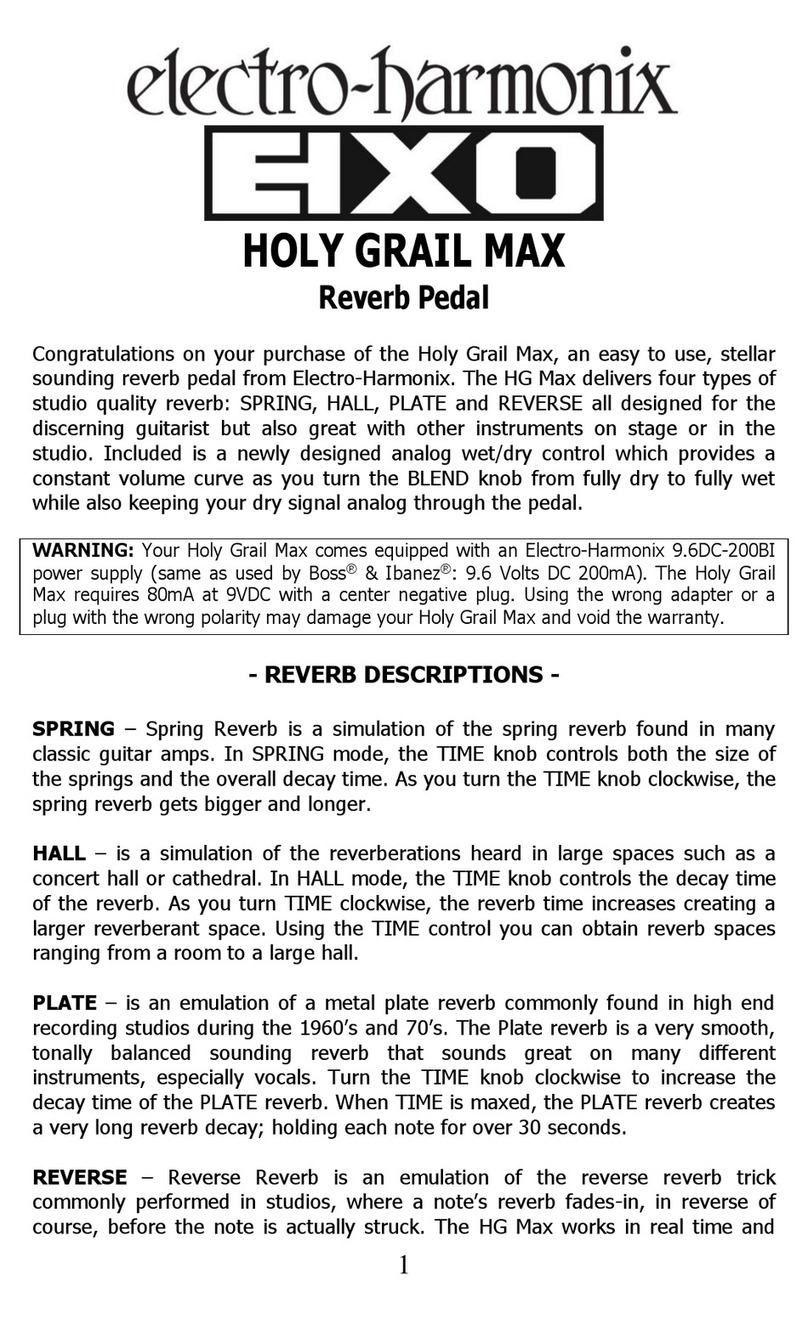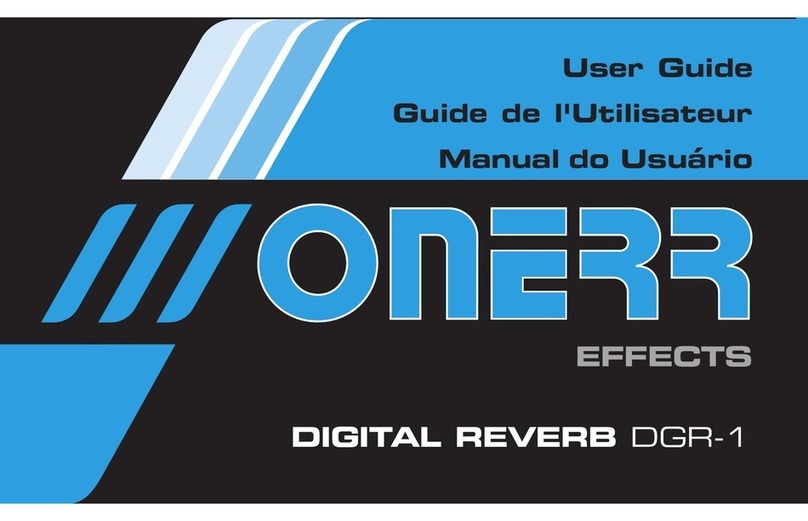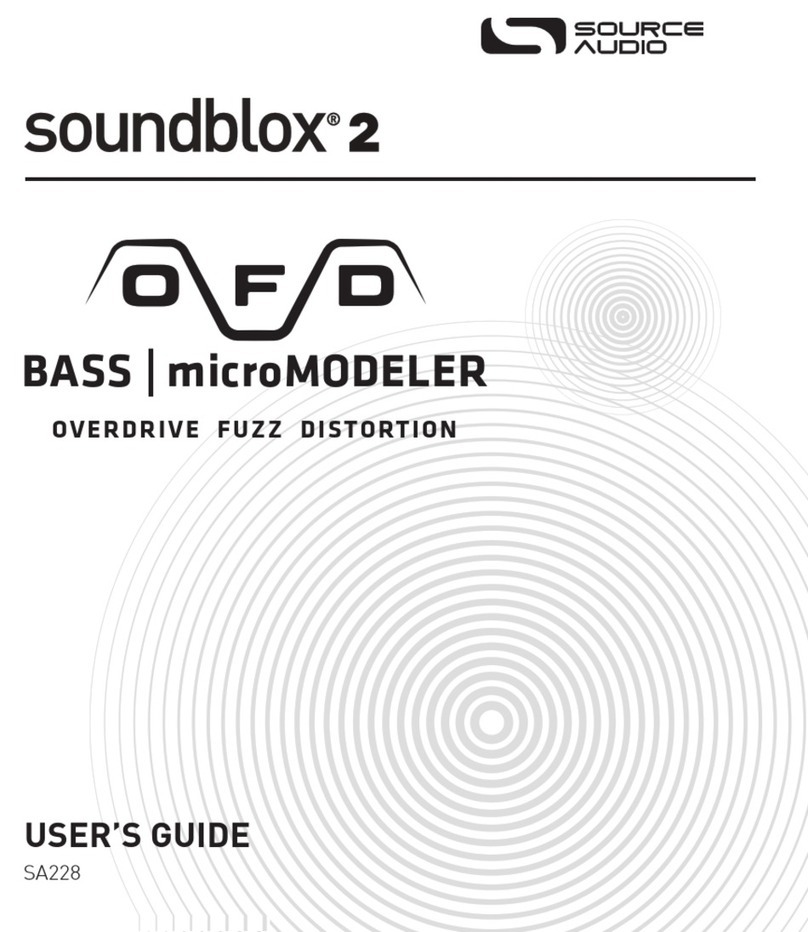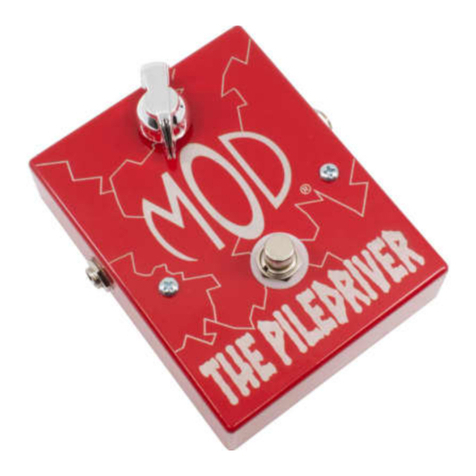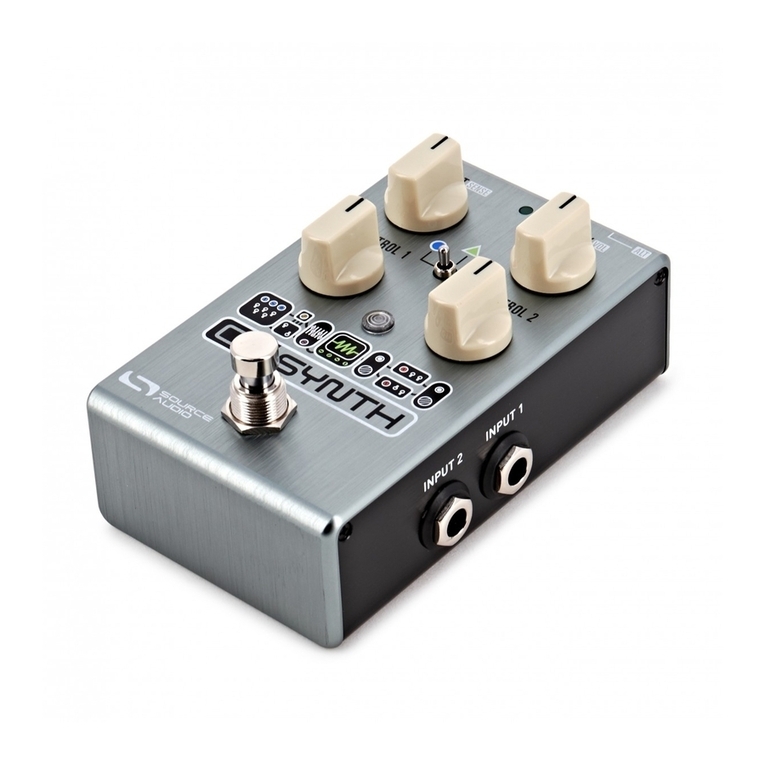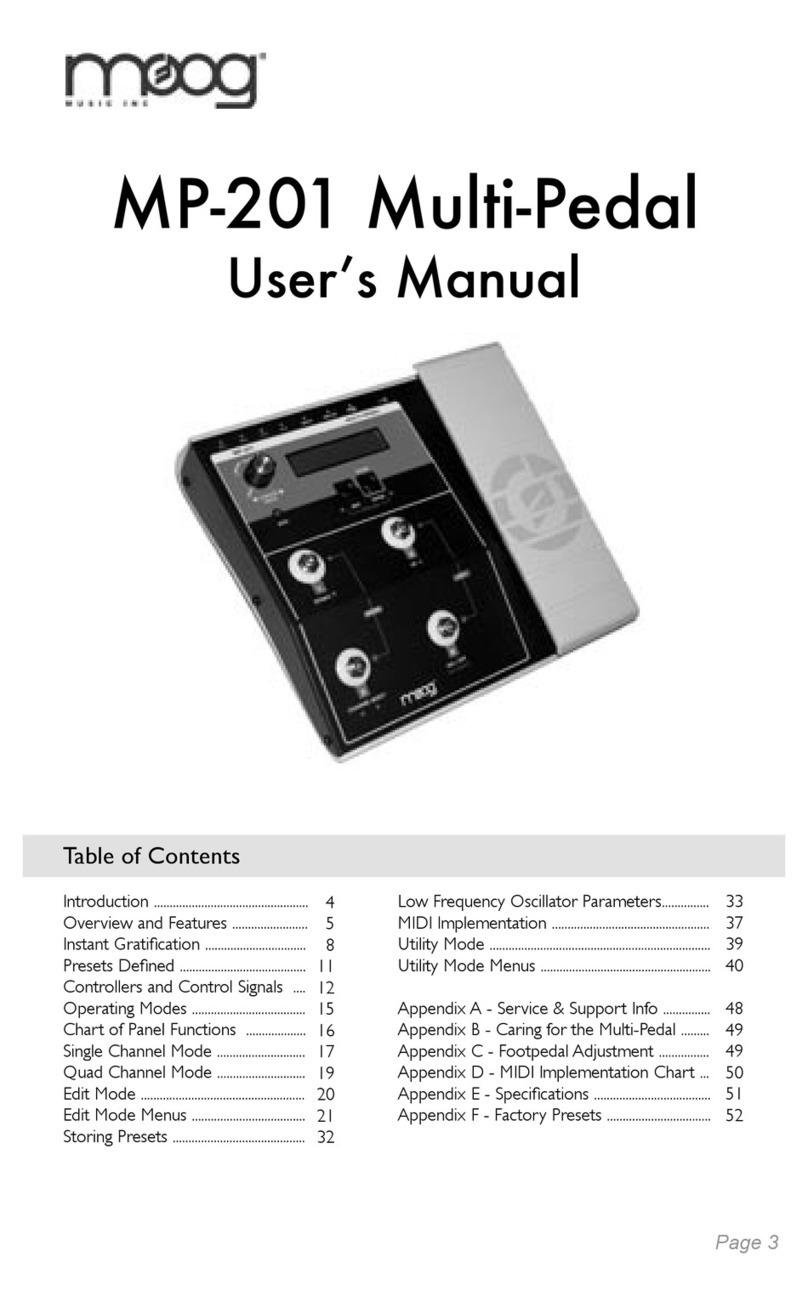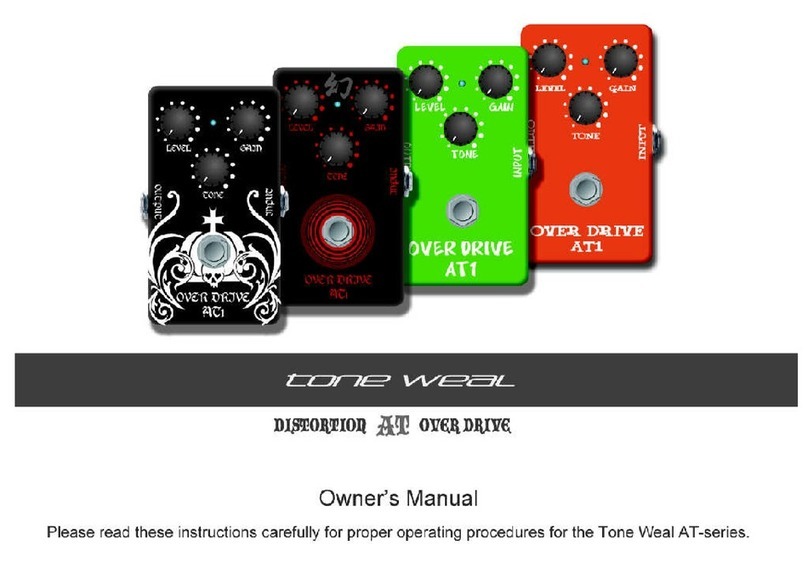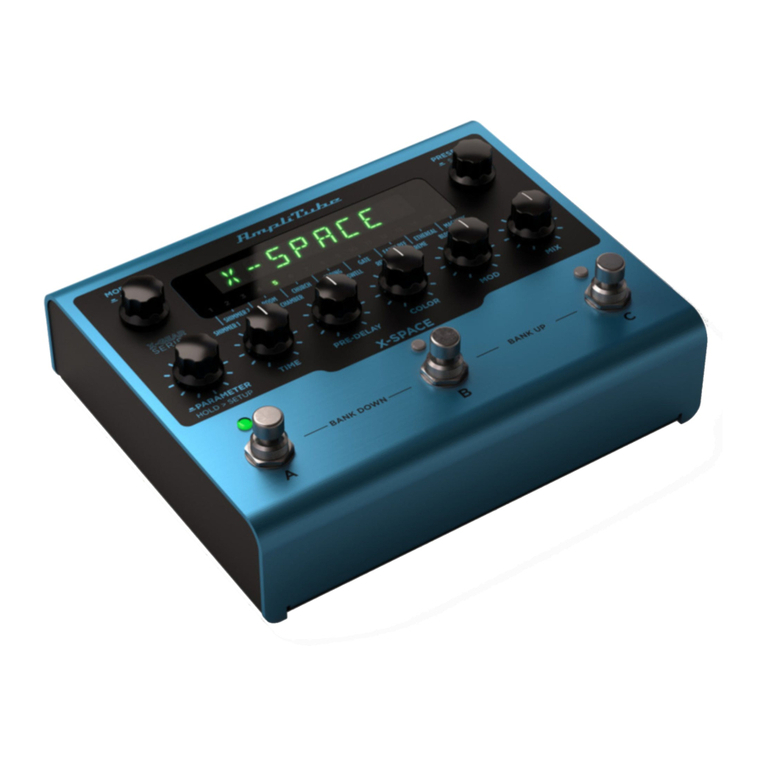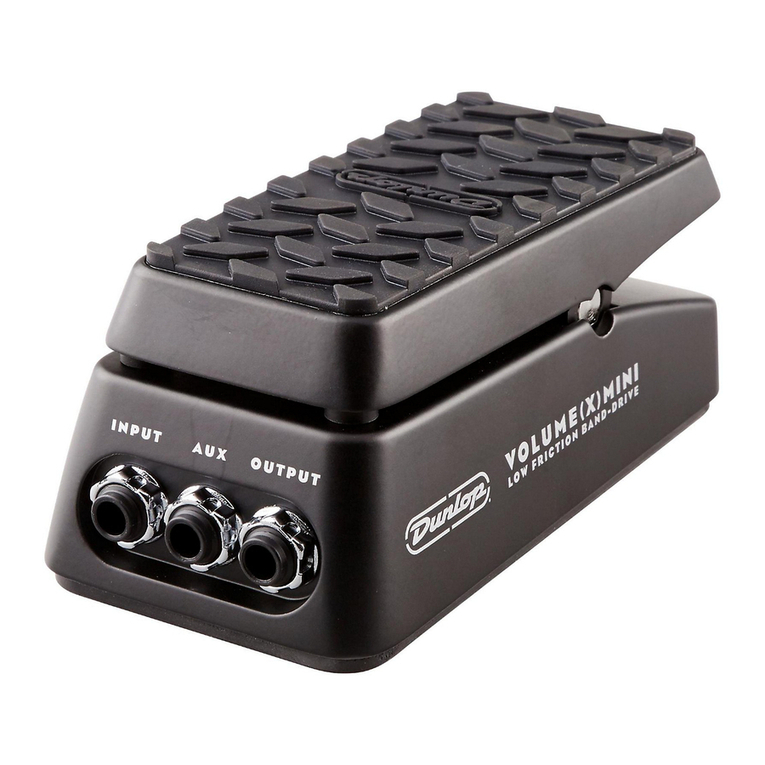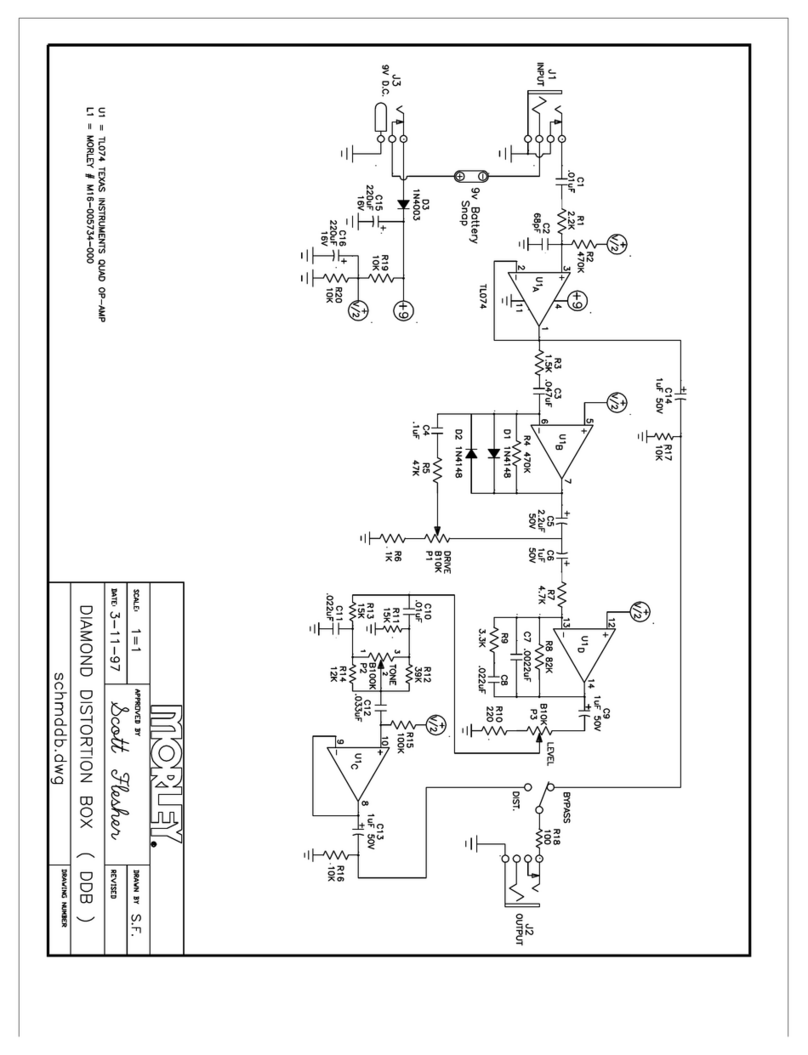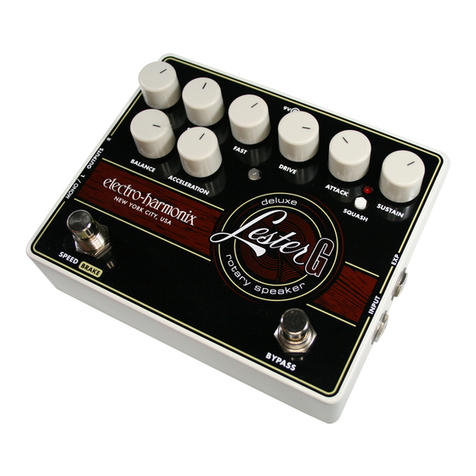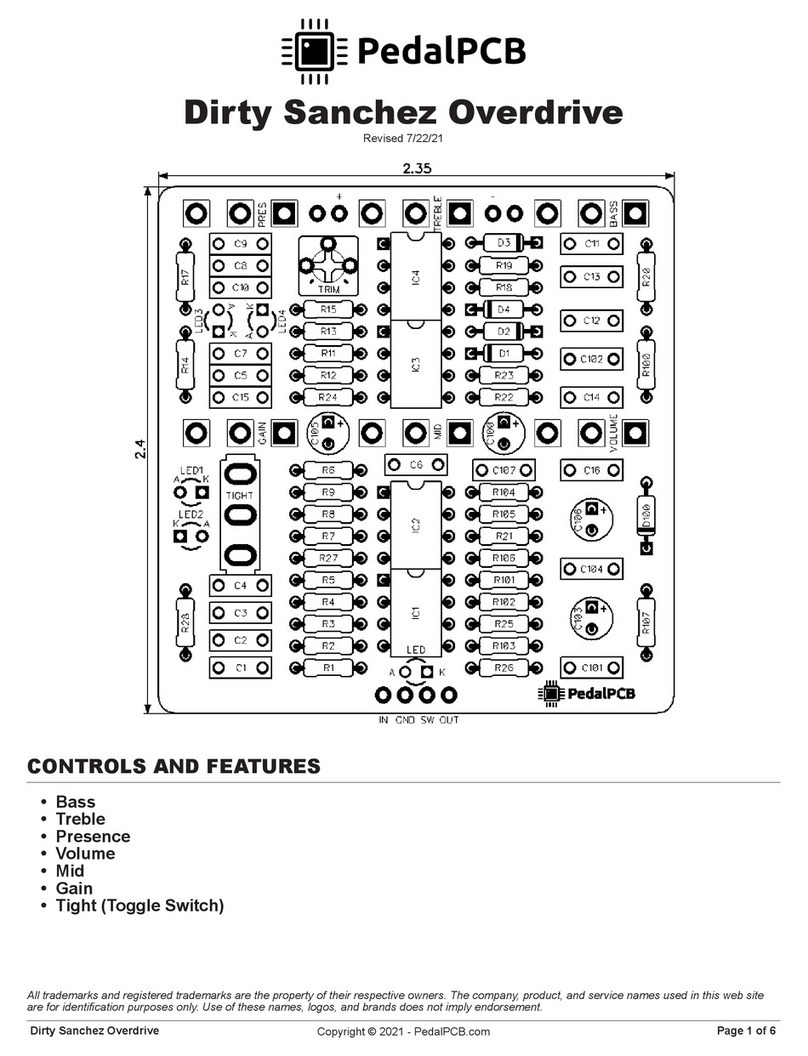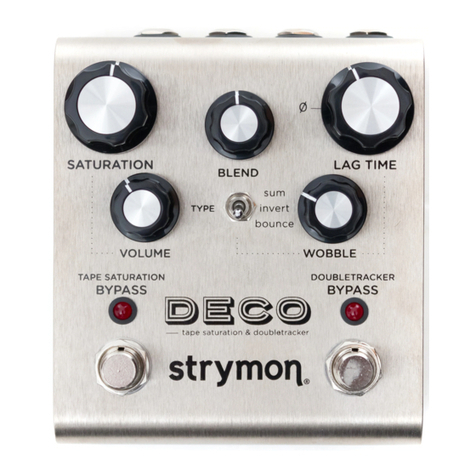Zoom GFX-3 User manual

USAGE AND SAFETY PRECAUTIONS . . . . . . . . . . . . . . . . . . . . . . . . . . . . . 2
Introduction . . . . . . . . . . . . . . . . . . . . . . . . . . . . . . . . . . . . . . . . . . . . . . . . . . 3
Controls and Functions . . . . . . . . . . . . . . . . . . . . . . . . . . . . . . . . . . . . . . . . . 4
Getting Ready to Play . . . . . . . . . . . . . . . . . . . . . . . . . . . . . . . . . . . . . . . . . . 6
Inserting the batteries . . . . . . . . . . . . . . . . . . . . . . . . . . . . . . . . . . . . . . . . . . . . . . . . . .6
Getting connected . . . . . . . . . . . . . . . . . . . . . . . . . . . . . . . . . . . . . . . . . . . . . . . . . . . .6
Quick Guide . . . . . . . . . . . . . . . . . . . . . . . . . . . . . . . . . . . . . . . . . . . . . . . . . . 8
Selecting and Playing Patches . . . . . . . . . . . . . . . . . . . . . . . . . . . . . . . . . . 10
Panel display . . . . . . . . . . . . . . . . . . . . . . . . . . . . . . . . . . . . . . . . . . . . . . . . . . . . . . . .10
Selecting a patch . . . . . . . . . . . . . . . . . . . . . . . . . . . . . . . . . . . . . . . . . . . . . . . . . . . .10
Using the internal tuner (bypass/mute) . . . . . . . . . . . . . . . . . . . . . . . . . . . . . . . . . . . .11
Changing the Sound of a Patch . . . . . . . . . . . . . . . . . . . . . . . . . . . . . . . . . 12
Patch configuration . . . . . . . . . . . . . . . . . . . . . . . . . . . . . . . . . . . . . . . . . . . . . . . . . . .12
Basic editing . . . . . . . . . . . . . . . . . . . . . . . . . . . . . . . . . . . . . . . . . . . . . . . . . . . . . . . .12
Storing a Patch . . . . . . . . . . . . . . . . . . . . . . . . . . . . . . . . . . . . . . . . . . . . . . . 14
Resetting the GFX-3 to the factory default condition . . . . . . . . . . . . . . . . . . . . . . . . .14
Other Functions . . . . . . . . . . . . . . . . . . . . . . . . . . . . . . . . . . . . . . . . . . . . . . 15
Using the expression pedal to vary an effect . . . . . . . . . . . . . . . . . . . . . . . . . . . . . . .15
Adjusting the expression pedal . . . . . . . . . . . . . . . . . . . . . . . . . . . . . . . . . . . . . . . . .16
Effect Types and Parameters . . . . . . . . . . . . . . . . . . . . . . . . . . . . . . . . . . . 17
◆
ZNR/[TOTAL] module . . . . . . . . . . . . . . . . . . . . . . . . . . . . . . . . . . . . . . . . . . . . . 17
◆
COMP/ISO (Compressor/Isolator) module . . . . . . . . . . . . . . . . . . . . . . . . . . . . . . 17
◆
DRIVE module . . . . . . . . . . . . . . . . . . . . . . . . . . . . . . . . . . . . . . . . . . . . . . . . . . . . 18
◆
EQ (Equalizer) module . . . . . . . . . . . . . . . . . . . . . . . . . . . . . . . . . . . . . . . . . . . . . 19
◆
MOD (Modulation) module . . . . . . . . . . . . . . . . . . . . . . . . . . . . . . . . . . . . . . . . . . 20
◆
REV/DLY (Reverb/Delay) module . . . . . . . . . . . . . . . . . . . . . . . . . . . . . . . . . . . . . 21
GFX-3 Patch List . . . . . . . . . . . . . . . . . . . . . . . . . . . . . . . . . . . . . . . . . . . . . . 23
Troubleshooting . . . . . . . . . . . . . . . . . . . . . . . . . . . . . . . . . . . . . . . . . . . . . . 24
Specifications . . . . . . . . . . . . . . . . . . . . . . . . . . . . . . . . . . . . . . . . . . . . . . . . 24
Operation Manual
© ZOOM Corporation
Reproduction of this manual, in whole or in part, by any means, is prohibited.
Contents
En-GFX3.book 1 ページ 2004年11月8日 月曜日 午後4時30分

ZOOM GFX-3
2
SAFETY PRECAUTIONS
In this manual, symbols are used to highlight warnings and
cautions for you to read so that accidents can be prevented. The
meanings of these symbols are as follows:
This symbol indicates explanations about
extremely dangerous matters. If users
ignore this symbol and handle the device
the wrong way, serious injury or death could
result.
This symbol indicates explanations about
dangerous matters. If users ignore this
symbol and handle the device the wrong
way, bodily injury and damage to the
equipment could result.
Please observe the following safety tips and precautions to ensure
hazard-free use of the GFX-3.
Power requirements
Since power consumption of this unit is fairly high, we
recommend the use of an AC adapter whenever possible.
When powering the unit from batteries, use only alkaline
types.
[AC adapter operation]
• Be sure to use only an AC adapter which supplies 9 V
DC, 300 mA and is equipped with a "center minus" plug
(Zoom AD-0006). The use of an adapter other than the
specified type may damage the unit and pose a safety
hazard.
• Connect the AC adapter only to an AC outlet that
supplies the rated voltage required by the adapter.
•When disconnecting the AC adapter from the AC outlet,
always grasp the adapter itself and do not pull at the
cable.
• During lightning or when not using the unit for an
extended period, disconnect theAC adapter from theAC
outlet.
[Battery operation]
• Use four conventional IEC R6 (size AA) batteries
(alkaline).
• The GFX-3 cannot be used for recharging. Pay close
attention to the labelling of the battery to make sure you
choose the correct type.
•When not using the unit for an extended period, remove
the batteries from the unit.
• If battery leakage has occurred, wipe the battery
compartment and the battery terminals carefully to
remove all remnants of battery fluid.
• While using the unit, the battery compartment cover
should be closed.
Environment
To prevent the risk of fire, electric shock or malfunction,
avoid using your GFX-3 in environments where it will be
exposed to:
• Extreme temperatures
• Heat sources such as radiators or stoves
• High humidity or moisture
• Excessive dust or sand
• Excessive vibration or shock
Handling
•Never place objects filled with liquids, such as vases, on
the GFX-3 since this can cause electric shock.
•Do not place naked flame sources, such as lighted
candles, on the GFX-3 since this can cause fire.
• The GFX-3 is a precision instrument. Do not exert
undue pressure on the keys and other controls. Also take
care not to drop the unit, and do not subject it to shock
or excessive pressure.
•Take care that no foreign objects (coins or pins etc.) or
liquids can enter the unit.
Connecting cables and input and output
jacks
You should always turn off the power to the GFX-3 and all
other equipment before connecting or disconnecting any
cables. Also make sure to disconnect all connection cables
and the power cord before moving the GFX-3.
Alterations
Never open the case of the GFX-3 or attempt to modify
the product in any way since this can result in damage to
the unit.
Volume
Do not use the GFX-3 at a loud volume for a long time
since this can cause hearing impairment.
Usage Precautions
• Electrical interference
For safety considerations, the GFX-3 has been designed to
provide maximum protection against the emission of
electromagnetic radiation from inside the device, and protection
from external interference. However, equipment that is very
susceptible to interference or that emits powerful
electromagnetic waves should not be placed near the GFX-3, as
the possibility of interference cannot be ruled out entirely.
With any type of digital control device, the GFX-3 included,
electromagnetic interference can cause malfunctioning and can
corrupt or destroy data. Care should be taken to minimize the risk
of damage.
• Cleaning
Use a soft, dry cloth to clean the GFX-3. If necessary, slightly
moisten the cloth. Do not use abrasive cleanser, wax, or solvents
(such as paint thinner or cleaning alcohol), since these may dull
the finish or damage the surface.
Please keep this manual in a convenient place for
future reference.
W
arning
Caution
USAGE AND SAFETY PRECAUTIONS
W
arning
Caution
Caution
Caution
W
arning
W
arning
W
arning
En-GFX3.book 2 ページ 2004年11月8日 月曜日 午後4時30分

ZOOM GFX-3
3
Introduction
Thank you for selecting the
ZOOM GFX-3
. This product is a sophisticated Guitar Effects Processor with
the following features.
●
Versatile array of effects
The Variable Architecture Modeling System (VAMS) developed by ZOOM adapts the
internal configuration of the unit to achieve exactly the desired sound. The GFX-3
provides 50 choices, ranging from distortion and modulation effects to spatial sound
processing.
●
Full complement of distortion effects
20 distortion type effects not only recreate the characteristics of famous vintage amps
but also duplicate the sound and operation of renowned compact effects and pedals.
The built-in acoustic simulator makes an electric guitar sound like an acoustic
instrument.
●
120 ready-to-use patches
Effect module setting combinations can be stored as patches. The GFX-3 offers 60
user patches which can be freely modified, plus 60 preset patches. Together, these 120
settings let you make great music straight away.
●
Mode-free editing for creative flexibility
The selectors and keys arranged on the panel let you directly access any effect.
Because there is no need for mode switching, editing can be performed quickly even
during a performance. The built-in pedal makes things even simpler by letting you
vary effect parameters in real time. The GFX-3 is a powerful tool for enhancing any
live performance.
●
Energizer produces powerful sound
The Energizer lets you match the output of the GFX-3 to the playback system. Enjoy
powerful, dynamic sound even with a small guitar amp or an audio system with flat
response.
●
Designed for use on stage
The metal chassis of the GFX-3 can withstand the rigors of use on stage. Stability is
excellent, and the dual power supply allows the unit to be powered either from an AC
adapter or from batteries. With one set of alkaline batteries, the unit will operate
continuously for up to 11 hours.
En-GFX3.book 3 ページ 2004年11月8日 月曜日 午後4時30分

ZOOM GFX-3
4
Controls and Functions
Top Panel
Rear Panel
Control section (→p.5)
Foot switches [1] - [3]
[INPUT] jack
[OUTPUT/PHONES] jack
[POWER] switch
[DC IN] jack
BANK [Q]/[W] keys
Expression pedal
En-GFX3.book 4 ページ 2004年11月8日 月曜日 午後4時30分

Controls and Functions
ZOOM GFX-3
5
Control section
Module keys
Display
[GROUP/EXIT] key
[STORE] key [VALUE] dial
[DRIVE] selector
[MOD] selector
[REV/DLY] selector
[PEDAL] key
Parameter keys
The FCC regulation warning (for U.S.A.)
This equipment has been tested and found to comply with the limits for a Class B digital
device, pursuant to Part 15 of the FCC Rules. These limits are designed to provide
reasonable protection against harmful interference in a residential installation. This
equipment generates, uses, and can radiate radio frequency energy and, if not installed and
used in accordance with the instructions, may cause harmful interference to radio
communications. However, there is no guarantee that interference will not occur in a
particular installation. If this equipment does cause harmful interference to radio or
television reception, which can be determined by turning the equipment off and on, the
user is encouraged to try to correct the interference by one or more of the following
measures:
• Reorient or relocate the receiving antenna.
• Increase the separation between the equipment and receiver.
•Connect the equipment into an outlet on a circuit different from that to
which the receiver is connected.
• Consult the dealer or an experienced radio/TV technician for help.
En-GFX3.book 5 ページ 2004年11月8日 月曜日 午後4時30分

ZOOM GFX-3
6
Getting Ready to Play
Inserting the batteries
To use the GFX-3 on battery power, insert
batteries as shown below.
1.
Turn the unit over and open the
battery compartment cover. (Push
the tab to unlock and then raise the
cover.)
2.
Insert the batteries with correct (+)
(-) polarity into the battery
compartment.
3.
Close the battery compartment
cover. (Make sure that the tab is
properly engaged.)
N
OTE
• When not using the unit for an extended
period, remove the batteries to prevent the
possibility of damage by leaking battery
fluid.
• If the indication "bt" alternates on the
display with the regular indication, the
batteries are almost exhausted. Replace
the batteries as soon as possible with fresh
ones.
Getting connected
1.
Make sure that the amplifier and
the GFX-3 are switched off.
Turn the volume at the amplifier to minimum.
2.
To power the unit from the AC
adapter, insert the small plug of the
adapter cable into the [DC IN] jack
on the GFX-3. Then plug the
adapter into an AC outlet.
3.
Connect the guitar to the [INPUT]
jack of the GFX-3, using a mono
cable.
4.
Connect the [OUTPUT/PHONES]
jack of the GFX-3 to the guitar amp,
using the cable.
To monitor the sound with headphones, plug the
phones into the [OUTPUT/PHONES] jack.
5.
Turn power on in the following
order: GFX-3
→
amplifier.
OPEN
Battery
compartment
cover
GFX-3 bottom
Tab
Four IEC R6 (size AA)
batteries
Battery
compartment cover
Battery polarity
alternates
for each slot.
BbT
En-GFX3.book 6 ページ 2004年11月8日 月曜日 午後4時30分

Getting Ready to Play
ZOOM GFX-3
7
N
OTE
If you turn the GFX-3 on while the amplifier is
already powered up, damage to the speaker
may result. Always turn power to the amplifier
on last. When turning off the system, proceed
in the opposite order.
6.
Press the leftmost module key
(ZNR/[TOTAL]) and then the lowest
parameter key.
The respective key flashes, and the Energizer
function for matching the GFX-3 to the playback
system can be used. The display shows the
current setting.
7.
While playing your instrument, turn
the [VALUE] dial until the sound
quality is as desired.
As you turn the dial, the display indication
changes between oF and 1 - 30. Higher setting
values result in stronger emphasis of the low
range, and lower setting values in stronger
emphasis of the high range. The "oF" setting
means that the Energizer function is turned off.
8.
To turn the system off, proceed in
the opposite order than when
turning it on.
Module key
(ZNR/[TOTAL])
Parameter key
Guitar
Guitar amps
Headphones
AC adapter
Connect the guitar output
jack to the [INPUT] jack on
the GFX-3.
Loop the cable of the AC
adapter around the hook before
connecting it to the [DC IN]
jack. This will prevent the plug
from being disconnected if the
cable is accidentally pulled.
Connect the separately available AC
adapter (ZOOM AD-0006) here.
When using only one guitar amp, connect it to the
[OUTPUT/PHONES] jack with a shielded instrument
cable. By using a Y-cable and connecting two guitar
amplifiers to the [OUTPUT/PHONES] jack, you can
achieve reverb and chorus sound with a wide stereo
spread.
En-GFX3.book 7 ページ 2004年11月8日 月曜日 午後4時30分

ZOOM GFX-3
8
Selecting a patch
Altering an effect
with the pedal
To select a patch, press one of the foot
switches [1] - [3] whose LED is not lit.
The single effects (effect modules) in the GFX-3
can be combined, and parameter settings for each
effect can be changed to achieve a desired sound.
Such a combination of effects with certain
parameter settings is called a patch. Patches are
always called onto the panel in banks of three, and
the foot switches [1] - [3] are used to select the
patch.
Move the expression pedal up
or down while playing your
instrument.
The effect depth or volume or another
parameter of the effect will change in
real time as you move the expression
pedal. (Which parameter changes
depends on the patch.)
* For some patches, the pedal has no
effect.
For an explanation of effect control with
the pedal, see page 15.
To switch to a patch in another group or
bank, use the BANK [Q]/[W] keys and
then the foot switches [1] - [3].
Patches are organized in user groups (U, u) which
can be modified, and preset groups (A, b) which are
read-only. Each group comprises ten banks
numbered from 0 to 9, and each bank has three
patches.
The BANK [Q]/[W] keys select groups and banks
in the order U0 - U9, u0 - u9, A0 - A9, b0 - b9.
* Pressing foot switches [1] and [2] together has the
same effect as pressing the BANK [W] key, and
pressing foot switches [2] and [3] together has the
same effect as pressing the BANK [Q] key.
For a detailed explanation of patch switching, see page
10.
Bank number
Group
1
Group U Group u Group A Group b
User groups Preset groups
BANK 9
BANK 2
BANK 2
BANK 2
BANK 2
BANK 2
BANK 2
BANK 2
BANK 1
PATCH 1
PATCH 2
PATCH 3
BANK 0
PATCH 1
PATCH 2
PATCH 3
BANK 9
BANK 2
BANK 2
BANK 2
BANK 2
BANK 2
BANK 2
BANK 2
BANK 1
PATCH 1
PATCH 2
PATCH 3
BANK 0
PATCH 1
PATCH 2
PATCH 3
BANK 9
BANK 2
BANK 2
BANK 2
BANK 2
BANK 2
BANK 2
BANK 2
BANK 1
PATCH 1
PATCH 2
PATCH 3
BANK 0
PATCH 1
PATCH 2
PATCH 3
BANK 9
BANK 2
BANK 2
BANK 2
BANK 2
BANK 2
BANK 2
BANK 2
BANK 1
PATCH 1
PATCH 2
PATCH 3
BANK 0
PATCH 1
PATCH 2
PATCH 3
Move back
and forth
Quick Guide
This section explains the basic operation steps, allowing you to use the unit right away.
En-GFX3.book 8 ページ 2004年11月8日 月曜日 午後4時30分

Quick Guide
ZOOM GFX-3
9
Storing effects
To switch the effect module on or
off, push the expression pedal fully
down.
The expression pedal also incorporates a
push-down switch that allows on/off control
of a specific effect module.
For an explanation of how to select the module
to be operated with the pedal, see page 15.
To store the modified patch, press the
[STORE] key.
The GFX-3 goes into store standby condition.
If necessary, use the BANK[Q]/[W] keys and the
foot switches [1] - [3] to select the bank and patch
number in which to store the current effect settings.
* If a patch from a preset group was selected, the patch
number 1 of user group bank "U0" will automatically
be selected as store target.
To carry out the store process, press the
[STORE] key once more.
To cancel the operation, press the [GROUP/EXIT]
key.
For a detailed explanation of the store procedure, see
page 14.
For information on how to return the user group patches
to the factory default condition, see page 14.
Modifying the sound of
a patch
[DRIVE] selector
Selects the DRIVE module
distortion type.
[REV/DLY] selector
Selects the REV/DLY module
effect type.
[MOD] selector
Selects the MOD module
effect type.
Module keys
Pressing these keys repeatedly switches the respective
module on and off.
While playing your instrument, use the
following selectors and keys.
2
1
2
Push down
all the way
En-GFX3.book 9 ページ 2004年11月8日 月曜日 午後4時30分

ZOOM GFX-3
10
Selecting and Playing Patches
Immediately after you turn on the GFX-3, it is always in the condition for playing patches stored in memory.
Panel display
Immediately after you turn on the GFX-3, the
following information is shown on the panel.
The keys for effect modules that are ON in this patch are lit.
Group (U/u, A/b) Bank number (0 - 9)
When a dot (.) is shown here,
patches can be selected from a user
group or preset group.
When a dot (.) is shown here,
the patch has been modified.
N
OTE
• While a patch is being modified, the
setting value of the currently selected
parameter is shown on the display. To
return to the group/bank display, press
the [GROUP/EXIT] key.
• While the setting value of a parameter is
shown, take care not to accidentally
switch the patch. Otherwise the setting
contents will be lost.
Selecting a patch
1.
To select a patch, press one of the
foot switches [1] - [3] whose LED is
not lit.
The LED of the foot switch for the patch that is
currently selected is lit.
N
OTE
If you press the foot switch whose LED is lit,
the unit goes into bypass/mute condition
(
→
p. 11).
2.
To select a patch in another group
or bank, use the BANK [Q
]/[W
] keys
and then the foot switches [1] - [3]
to select the group and bank.
For example, if you repeatedly press the BANK
[Q
] key, the group/bank is switched as follows.
Pressing foot switches [1] and [2] together has
the same effect as pressing the BANK [W
] key,
and pressing foot switches [2] and [3] together
has the same effect as pressing the BANK [Q
]
key.
3.
To limit the patch selection to user
groups or preset groups only,
press the [GROUP/EXIT] key.
Each time you press the key, the available
groups change as follows.
A0 A1 A9 B0 B9
User groups
Preset groups
A1
Preset groups
only
Both groups
User groups
only
Dot is lit
En-GFX3.book 10 ページ 2004年11月8日 月曜日 午後4時30分

Selecting and Playing Patches
ZOOM GFX-3
11
Using the internal tuner
(bypass/mute)
The GFX-3 has a built-in auto-chromatic tuner
for guitars. To use the tuner function, the built-in
effects must be bypassed (temporarily turned
off) or the unit must be muted (original sound
and effect sound turned off).
1.
To set the GFX-3 to the bypass
(mute) condition, press the foot
switch of the currently selected
patch (the switch whose LED is lit).
Pressing and immediately releasing the foot
switch sets the GFX-3 to the bypass condition.
The expression pedal is automatically switched
to function as a volume pedal.
Pressing and holding the foot switch for more
than one second sets the GFX-3 to the mute
condition.
2.
Play the open string you want to
tune.
The display shows the note which is closest to
the current pitch. Adjust the pitch so that the
indicator shows the desired note.
3.
To change the reference pitch of
the tuner, use the [VALUE] dial.
The current reference pitch is briefly shown on
the display. The default setting after power-on is
40 (center A = 440 Hz).
While the reference pitch is shown, you can
change the pitch by turning the [VALUE] dial.
The setting range is 35 (435 Hz) - 45 (445 Hz) in
1-Hz steps. When the GFX-3 is turned off and on
again, it will be reset to 440 Hz.
4.
To return to the normal condition,
press one of the foot switches [1] -
[3].
The patch of that foot switch becomes active again.
N
OTE
If you switch the bank/group while using the
tuner, the tuner function will be temporarily
disabled. When you return to the original
bank/group, the tuner function becomes
active again.
Release immediately
Bypass
Press and release after
more than 1 second
Mute
A
A
B
C
C
D
DG
G
E
F
F
The note is shown on the left part of the display.
The more the pitch is off, the faster the rotation of the display.
Pitch is sharp Correct pitch Pitch is flat
En-GFX3.book 11 ページ 2004年11月8日 月曜日 午後4時30分

ZOOM GFX-3
12
INPUT OUTPUT
MODDRIVE REV/DLYCOMP/ISO ZNREQUALIZER CABINET
Changing the Sound of a Patch
The patches of the GFX-3 can be modified by changing effect types and parameters. This section shows
how to edit patches.
Patch configuration
Each patch of the GFX-3 consists of several
effects (effect modules), as shown in the
illustration above. A patch is a stored
combination of modules, each with their distinct
parameter settings.
Within each module, there are several different
but related effects which are called effect types.
For example, the MOD (modulation) module
comprises effect types such as CHORUS,
PHASER, and WAH, of which one can be
selected.
The elements that determine the sound of a patch
are called effect parameters. Each module has
certain effect parameters, whose value can be
adjusted with the effect module keys,
PARAMETER keys, [VALUE] dial, etc.
N
OTE
Also within the same module, different effect
types will have different parameters.
Basic editing
The most common steps for editing a patch are
shown below. For a detailed description of effect
types and parameters in each module, see the
section "Effect Types and Parameters" on pages
17 - 22.
1.
Select the patch to edit.
Patches for editing can be selected from either a
preset group (A, b) or a user group (U/u).
Patches from a preset group are read-only. If you
have altered such a patch and want to keep it,
you must store it in a user group (
→
p.14
).
2.
To change the patch level, operate
the [VALUE] dial.
While the group/bank number indication is
shown on the display, the [VALUE] dial can be
used to adjust the patch level (final output level
of the patch).
When you turn the dial, the current patch level
setting (1 - 30) appears on the display. A dot (.)
in the bottom right of the display indicates that
the patch has been edited.
3.
If required, use the three selectors
to choose the DRIVE, MOD, and
REV/DLY module effect type.
The distortion type of the DRIVE module is set
with the [DRIVE] selector and the two module
keys ([CLASSIC]/[STANDARD]).
[CLASSIC]
key
[STANDARD]
key
[DRIVE]
selector
En-GFX3.book 12 ページ 2004年11月8日 月曜日 午後4時30分

Changing the Sound of a Patch
ZOOM GFX-3
13
ZNR/[TOTAL] module
COMP/ISO (Compressor/Isolator) module
DRIVE module
EQ(Equalizer) module
MOD(Modulation) module
REV/DLY(Reverb/Delay) module
The effect type of the MOD and REV/DLY
modules is set with the [MOD] selector and
[REV/DLY] selector respectively.
4.
Use the module keys to select the
module to edit.
The module keys serve for selecting an effect
module to work with. The assignment of keys to
effect modules is shown above.
The keys for modules that are ON in a given
patch are lit. When you press a key to select the
module, the light flashes. (If you select a module
that is currently off, the key flashes more
slowly.)
5.
To switch the module between ON
and OFF, press the module key
once more.
6.
Select the parameter to edit with
the parameter keys.
The parameter keys serve for choosing a
parameter within the currently selected module.
Each push of the key brings up the next
parameter, and the setting value of that
parameter is shown on the display.
The parameters that are assigned to the
parameter keys for each module are printed on
the panel. When the EQ module is selected, the
parameter keys correspond to the following
parameters.
NOTE
When you use the selector to switch the
effect type, the parameter type also changes.
Select the effect type first, and then select the
parameter.
7.
Use the [VALUE] dial to change the
setting.
The [VALUE] dial controls the setting value of
the currently selected parameter. The current
setting value is shown on the display.
8.
Repeat steps 3 - 7 to edit other
modules and parameters.
NOTE
To keep the patch, be sure to perform the
steps for storing it (
→
p. 14). Otherwise all
changes will be lost when you switch to
another patch.
[MOD] Selector [REV/DLY] Selector
EQ modul
PRESENCE
TREBLE
MIDDLE
BASS
Parameters
En-GFX3.book 13 ページ 2004年11月8日 月曜日 午後4時30分

ZOOM GFX-3
14
Storing a Patch
This section shows how to store an edited patch in memory.
1.
Press the [STORE] key.
The GFX-3 goes into store standby condition.
The display shows the current group name and
bank number, and the LED of the respective foot
switch lights up.
HINT
A patch can be stored either while playing it
or while it is being edited.
2.
Use the BANK
[Q
]/[W
]
keys and the
foot switches [1] - [3] to select the
bank and patch number in which to
store the patch.
NOTE
Patches cannot be stored in a preset group. If
a patch from a preset group was selected
when you press the [STORE] key, the patch
number 1 of user group bank "U0" will
automatically be preselected as store target.
3.
Press the [STORE] key once more.
The patch is stored, and the display shows the
group and bank of the store target. Since the
edited contents are now stored, the "EDITED"
dot on the display disappears.
If you press the [GROUP/EXIT] key instead of
the [STORE] key, storing is canceled.
Resetting the GFX-3 to the
factory default condition
The patches in the user groups can be returned to
their original condition at any time, even if you
have changed them.
1.
Turn power to the GFX-3 on while
keeping the [STORE] key
depressed.
The indication “AL” is shown on the display.
2.
Press the [STORE] key once more.
All patches are reset to the factory default
condition, and the unit automatically switches to
play mode.
By pressing the [GROUP/EXIT] key before
carrying out step 2, you can cancel the operation
and go directly to the normal condition.
En-GFX3.book 14 ページ 2004年11月8日 月曜日 午後4時30分

ZOOM GFX-3
15
Other Functions
This section explains how to vary an effect parameter with the expression pedal, and how to perform
special functions such as adjusting the expression pedal.
Using the expression
pedal to vary an effect
1.
Use the BANK
[Q
]/[W
]
keys and
foot switches [1] - [3] to select the
patch to be controlled by the
expression pedal.
2.
Repeatedly press the [PEDAL] key
to select the module to control.
The [PEDAL] key selects the module that will be
controlled by the expression pedal. The currently
selected module is indicated by the row of LEDs
just below the key. Each push of the key cycles
through the DRIVE
→
MOD
→
REV/DLY
→
VOLUME settings. The controlled parameter
with each setting is described below.
• DRIVE
Expression pedal adjusts GAIN parameter of
DRIVE module (BODY parameter for some
effect types). The distortion amount changes.
• MOD
Expression pedal adjusts effect type currently
selected in MOD module. The parameter
depends on the effect type.
• REV/DLY
Expression pedal adjusts effect type currently
selected in REV/DLY module. The parameter
depends on the effect type.
• VOLUME
Expression pedal adjusts the volume before input
to the MOD module.
HINT
• For information on controlled parameters
when "MOD" or REV/DLY" is selected, see
pages 17 - 22.
•If the module that was selected as control
target is currently OFF, the pedal will have
no effect until it is fully pushed down to
switch the module ON.
3.
Play your instrument and move the
expression pedal to try out the
effect.
If necessary, edit the effect type or effect
parameter that is being controlled.
HINT
• The selected control target is stored
separately for each patch. If necessary,
store the patch (
→
p. 14).
• By pushing the expression pedal fully
down, you can switch the controlled effect
module ON and OFF.
En-GFX3.book 15 ページ 2004年11月8日 月曜日 午後4時30分

Other Functions
ZOOM GFX-3
16
Adjusting the expression
pedal
The expression pedal is adjusted for optimum
operation at the factory, but sometimes,
readjustment may be necessary. If pushing the
pedal fully down does not have a strong effect,
or if the volume or sound changes excessively
even when the pedal is only lightly pushed,
calibrate the pedal as follows.
1.
Hold down the [PEDAL] key while
turning power to the GFX-3 on.
The indication "dn" appears on the display.
2.
Fully raise the expression pedal
and press the [STORE] key.
The indication "UP" appears on the display.
3.
Push the expression pedal fully
down and release it.
4.
Press the [STORE] key.
The adjustment is complete, and group/bank
display for the patch appears again.
HINT
• The position of the pedal in step 3
determines the module on/off switching
point. If you want the pedal to perform on/
off switching with a lighter touch, set the
pedal in step 3 to a somewhat higher
position.
•
If the indication "Er" is shown, repeat the
procedure from step 2.
Pedal fully raised
Push strongly, so that
pedal touches here.
When foot is lifted,
pedal returns slightly.
En-GFX3.book 16 ページ 2004年11月8日 月曜日 午後4時30分

ZOOM GFX-3
17
Effect modules
Effect types
MOD
CHORUS
FLANGE
PHASE
WAH
TREM/PAN
VIBE
PITCH
SFX
SLOW-A
RING
PDL-PIT
DRIVE
FDR
MS
BG
CLEAN
HI-GAIN
ZOOM
OVER DRIVE
DIST
FUZZ
METAL
ACOUSTIC
REV/DLY
HALL
ROOM
SPRING
MN-DLY
PP-DLY
ECHO
PP-ECHO
REVERSE
DLY+HALL
DLY+ROOM
DLY+SPRING
COMP/ISO
COMP
ISOLATOR
ZNR
ZNR
D GATE
EQUALIZER CABINET
BOX
Z BOX
BR CMB
CMB
CMB+EV
STK
STK+EV
Effect Types and Parameters
In this section, all effect types and parameters of the modules in the GFX-3 are explained. As shown in the
illustration, the GFX-3 has eight effect modules which can be thought of as being connected in series. It is
possible to use all effect modules together, or to switch individual modules on and off. Nearly all modules
incorporate several effect types, of which one can be selected at a time.
The effect types and parameters that can be used in each module are listed below. The pedal symbol ( )
indicates that the parameter can be assigned to the expression pedal in real time (
→
p. 15).
◆
ZNR/[TOTAL] module
This module serves for adjusting ZNR (ZOOM Noise Reduction), patch level, and other parameters that are common to
all patches.
◆
COMP/ISO (Compressor/Isolator) module
The compressor serves to reduce excessive signal levels. The isolator allows cutting or emphasizing a particular band.
Parameter 1 ZNR/D GATE Parameter 2 PATCH LEVEL
oF, Z1 – Z8, G1 – G8 1 – 30
Adjusts ZNR/noise gate sensitivity. With the Z1 - Z8 settings, ZNR is
enabled. With the G1 - G8 settings, noise gate is enabled. Set the value
for maximum noise reduction (higher settings) without producing
unnatural sound cutoff.
Adjusts the final patch output level.
Parameter 3 MASTER LEVEL Parameter 4 ENERGIZE
0 – 30 oF, 1 – 30
Adjusts the master level for all patches.
Controls the Energizer setting that applies to all patches. Lower values
result in stronger emphasis on treble, and higher values result in
stronger emphasis on bass. The "oF" setting disables the Energizer.
Parameter 1 COMP/ISO Parameter 2 ATTACK/HIGH
CO, IS ATTACK (CO) HIGH (IS)
FS, SL oF, -12 – 12
Select the effect by choosing CO (Compressor) or IS (Isolator). The
effect of parameters 2 - 4 differs, depending on which setting is chosen
here.
The time lag between signal input
and start of compressor action can
be set to FS (FAST) or SL
(SLOW).
Adjusts high-range mix.
En-GFX3.book 17 ページ 2004年11月8日 月曜日 午後4時30分

DRIVE module
ZOOM GFX-3
18
◆
DRIVE module
This module comprises 20 types of distortion and acoustic simulator effects. Effect types are chosen with the [DRIVE]
selector and the two module keys ([CLASSIC]/[STANDARD]).
*Parameters for TYPE 1 – 10 are the same.
Parameter 3 SENS/MID Parameter 4 LEVEL/LOW
SENS (CO) MID (IS) LEVEL (CO) LOW (IS)
0 – 10 oF, -12 – 12 1 – 8 oF, -12 – 12
Adjusts compressor sensitivity. Adjusts mid-range mix. Adjusts signal level after passing
module. Adjusts low-range mix.
TYPE1:FDR (
FF
FFDD
DD
)
CLASSIC FD BLU STANDARD FD CLN
Classic bluesy sound of a built-in tube amp Clean sound of a built-in tube amp
TYPE 2:MS (
MM
MMSS
SS
)
CLASSIC MS OLD STANDARD MS DRV
Old-style sound of a British tube stack amp Drive sound of a British tube stack amp
TYPE 3:BG (
BB
BBGG
GG
)
CLASSIC BG OLD STANDARD BG DRV
Old-style sound of a tube combo amp with gutsy midrange Drive sound of a tube stack amp with gutsy midrange
TYPE 4:CLEAN (
CC
CCLL
LL
)
CLASSIC VX CRU STANDARD JAZZ C
Old-style crunch sound Clean and bright combo amp sound
TYPE 5: HI-GAIN (
HH
HHGG
GG
)
CLASSIC MP 1 STANDARD PV DRY
High-gain tube preamp sound Tube stack amp sound for heavy metal
TYPE 6: ZOOM (
ZZ
ZZMM
MM
)
CLASSIC 9002 STANDARD Z PWR
ZOOM's original 9002 type sound ZOOM's original powerful amp type sound
TYPE 7:OVER DRIVE (
OO
OODD
DD
)
CLASSIC V-OD STANDARD PD 1
Dry overdrive sound Overdrive sound with wide application range, from booster to hard
distortion
TYPE 8: DIST (
DD
DDTT
TT
)
CLASSIC V-DIST STANDARD HP DST
Characteristic dry distortion sound Extreme distortion sound
TYPE 9: FUZZ (
FF
FFUU
UU
)
CLASSIC WILDFZ STANDARD UF1
Older-style, high-gain aggressive fuzz sound ZOOM original wild fuzz sound
TYPE 10: METAL (
MM
MMTT
TT
)
CLASSIC MTZ STANDARD MT 7TH
Traditional metal style sound with prominent midrange Metal sound for 7-string guitar
Parameter 1 GAIN Parameter 2 TONE
1 – 30 0 – 10
Adjusts distortion intensity. Adjusts tone.
Parameter 3 CABINET Parameter 4 LEVEL
oF, bo, Zb, bC, CM, CE, St, SE 1 – 8
Selects the cabinet type. (See Table 1) Adjusts signal level after passing module.
En-GFX3.book 18 ページ 2004年11月8日 月曜日 午後4時30分

EQ (Equalizer) module
ZOOM GFX-3
19
[Table 1]
◆
EQ (Equalizer) module
This is a 4-band equalizer.
◆
MOD (Modulation) module
This module contains modulation type effects such as chorus and flanger, effects that drastically change the sound such as
wah, filter, and ring modulator, and pitch altering effects such as pitch shift and vibrato.
Setting Description Setting Description
oF
Turns the cabinet simulator off.
CM
Simulates a general type combo amp cabinet.
bo
Simulates a small amp cabinet.
CE
Simulates an EV speaker in a combo amp cabinet.
Zb
Simulates a cabinet with ZOOM's original sound character.
St
Simulates a stack amp cabinet.
bC
Simulates a bright combo amp cabinet.
SE
Simulates an EV speaker in a stack amp cabinet.
TYPE 11: ACOUSTIC (
AA
AACC
CC
)
CLASSIC ACFAT STANDARD AC BRI
Changes the sound of an electric guitar to resemble an acoustic guitar. The CLASSIC and STANDARD settings give a different sound character.
Parameter 1 TOP Parameter 2 BODY
1 – 10 1 – 10
Adjusts characteristic acoustic guitar string sound. Adjusts body resonance.
Parameter 3 CABINET Parameter 4 LEVEL
oF, bo, Zb, bC, CM, CE, St, SE 1 – 8
Selects the cabinet type. Adjusts signal level after passing module.
Parameter 1 PRESENCE Parameter 2 TREBLE
-12 – 12 -12 – 12
Adjusts boost/cut in high range (center frequency 8 kHz). Adjusts boost/cut in mid-high range (center frequency 3.125 kHz).
Parameter 3 MIDDLE Parameter 4 BASS
-12 – 12 -12 – 12
Adjusts boost/cut in middle range (center frequency 8 kHz). Adjusts boost/cut in low range (center frequency 125 Hz).
TYPE 1: CHORUS (
CC
CCHH
HH
)
Adds pulsation and spaciousness to the sound.
Parameter 1 COLOR Parameter 2 DEPTH
C1, C2 0 – 10
Selects the chorus character. C1 gives a modern stereo chorus, and C2 a
vintage chorus sound. Adjusts modulation intensity.
Parameter 3 RATE Parameter 4 MIX
1 – 30 0 – 30
Adjusts modulation speed. Adjusts mixing balance of original sound and effect sound.
TYPE 2: FLANGE (
FF
FFLL
LL
)
Produces a unique, undulating sound.
Parameter 1 COLOR Parameter 2 DEPTH
1 – 30 0 – 10
Sets the pre-delay. Adjusts modulation intensity.
Parameter 3 RATE Parameter 4 RESO
1 – 30 -10 – 10
Adjusts modulation speed. Adjusts feedback ratio. Higher values in positive or negative direction
result in stronger characteristics.
En-GFX3.book 19 ページ 2004年11月8日 月曜日 午後4時30分

MOD (Modulation) module
ZOOM GFX-3
20
TYPE 3: PAHSE (
PP
PPHH
HH
)
Produces a swooshing sound.
Parameter 1 COLOR Parameter 2 POSI
1 – 4 AF, bF
Selects sound character. Selects connection point of MOD module. AF (after CABINET
module) or bF (before DRIVE module) can be selected.
Parameter 3 RATE Parameter 4 RESO
1 – 30 1 – 10
Adjusts modulation speed. Adjusts the feedback amount. Higher values give a stronger character.
TYPE 4: WAH (
WW
WWAA
AA
)
Wah effect with selectable auto wah and pedal wah.
Parameter 1 CONTROL Parameter 2 POSI
Au, Ad, Pd AF, bF
Selects the wah operation method. "Au" gives upward auto wah, and
"Ad" gives downward auto wah. "Pd" gives pedal wah. Selects connection point of MOD module.
Parameter 3 SENS/FREQ Parameter 4 RESO/MIX
1 – 10 0 – 10
Adjusts auto wah sensitivity when Au/Ad is selected for parameter 1.
When Pd is selected, this parameter adjusts the pedal wah center
frequency.
Adjusts auto wah character intensity when Au/Ad is selected for
parameter 1. When Pd is selected, this parameter adjusts the original
sound mix amount.
TYPE 5: TREM/PAN (
TT
TTMM
MM
) (Tremolo/Pan)
This effect can be used for tremolo or auto panning.
Parameter 1 COLOR Parameter 2 DEPTH
Mn, St 0 – 10
Selects the effect type. "Mn" gives tremolo, and "St" gives auto
panning. Adjusts modulation intensity.
Parameter 3 RATE Parameter 4 CLIP
1 – 30 0 – 10
Adjusts modulation speed. Higher values result in stronger modulation character through clipping
of the modulation waveform.
TYPE 6: VIBE (
VV
VVBB
BB
) (Vibrato)
This is an automatic vibrato effect.
Parameter 1 COLOR Parameter 2 DEPTH
0 – 10 0 – 10
Adjusts the sound quality of the effect sound. Adjusts effect depth.
Parameter 3 RATE Parameter 4 MIX
1 – 30 0 – 30
Adjusts effect speed. Adjusts original sound mix.
TYPE 7: PITCH (
PP
PPTT
TT
) (Pitch Shifter)
This effect can shift the pitch up or down.
Parameter 1 DELAY Parameter 2 SHIFT
0 – 30 -12 – -1, dt, 1 – 12, 24
Adjusts the delay time of the effect sound.
Sets the pitch shift amount. The "dt" setting results in a detune effect.
Parameter 3 TONE Parameter 4 MIX
0 – 10 0 – 30
Adjusts effect tone. Adjusts original sound mix.
TYPE 8: SFX (
SS
SSFF
FF
) (Special Effects)
Uses random waveform and envelope processing to create a special kind of sound.
Parameter 1 COLOR Parameter 2 DEPTH
0 – 10 0 – 10
Selects the way the sound is modulated. With the "0" setting, the sound
is modified using a random, stair-shaped waveform. With the "10"
setting, the level changes of the original sound are reflected in the effect
sound. Intermediate values result in intermediate effect action.
Adjusts the effect depth (sensitivity). When parameter 1 has been set to
a fairly high value, increasing this parameter results in varied delay time
according to signal intensity.
En-GFX3.book 20 ページ 2004年11月8日 月曜日 午後4時30分
Table of contents
Other Zoom Music Pedal manuals

Zoom
Zoom 506 BASS User manual
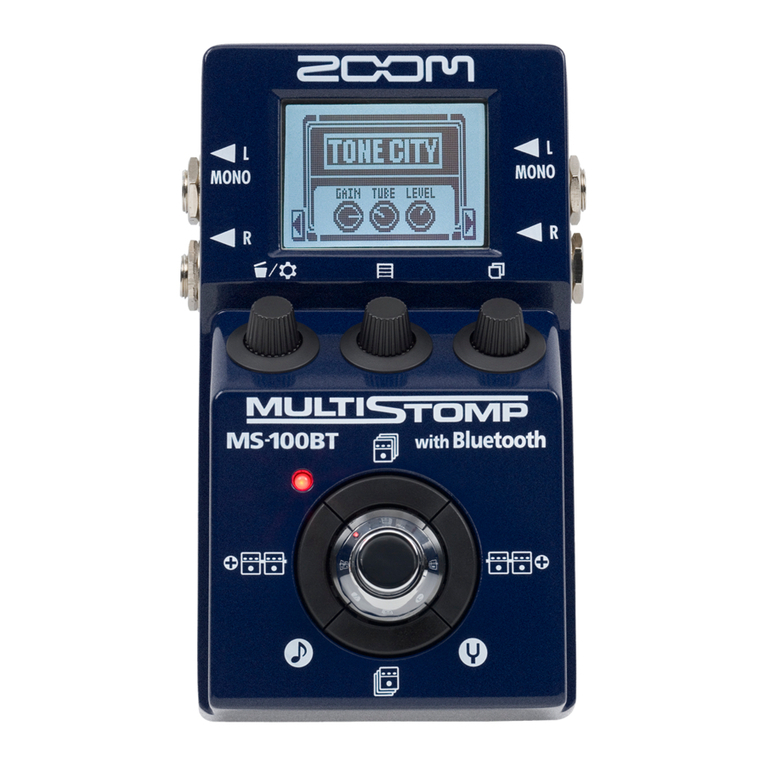
Zoom
Zoom MULTISTOMP MS-100BT General instructions

Zoom
Zoom B22 User manual
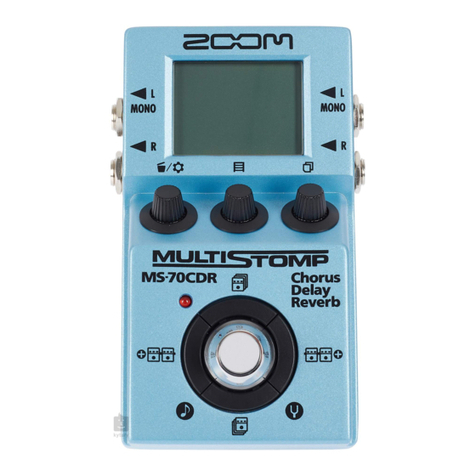
Zoom
Zoom Multistomp MS-70CDR Mounting instructions

Zoom
Zoom G1 Four User manual

Zoom
Zoom 506II Bass User manual
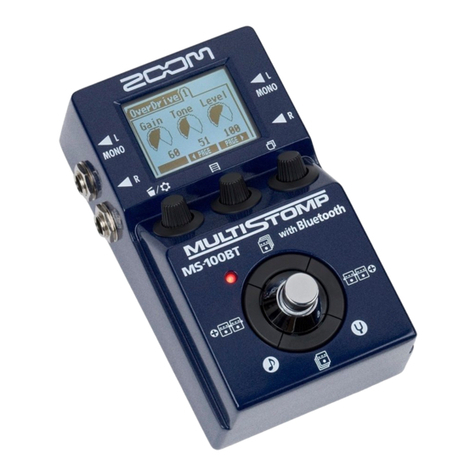
Zoom
Zoom MULTISTOMP MS-100BT User manual

Zoom
Zoom MultiStomp MS-50G User manual
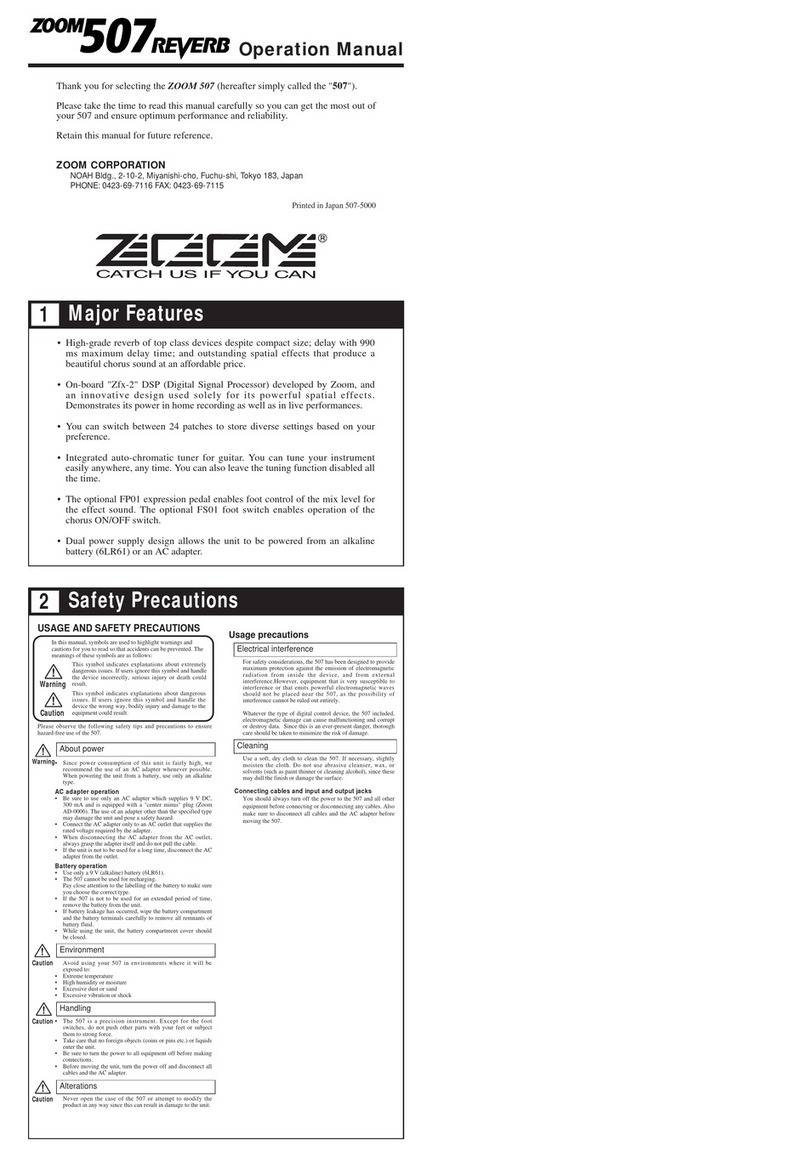
Zoom
Zoom 507 REVERB User manual
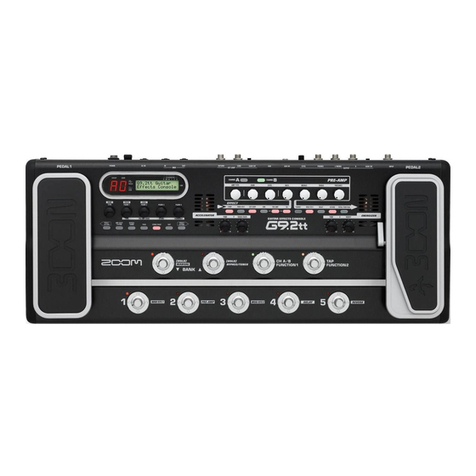
Zoom
Zoom Guitar Effects Console G9.2tt2q User manual

Zoom
Zoom g9.2tt User manual

Zoom
Zoom 505 GUITAR User manual
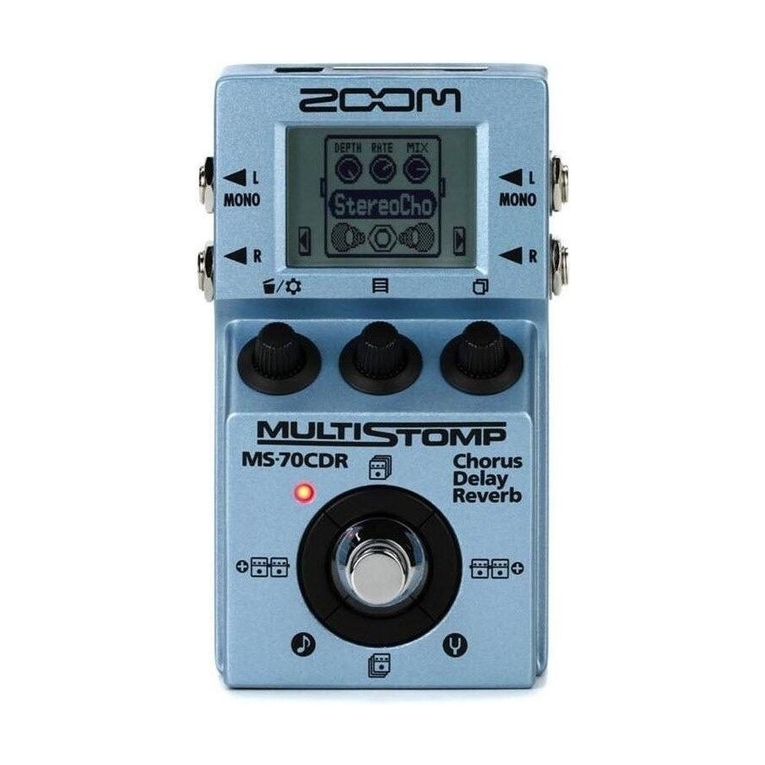
Zoom
Zoom Multistomp MS-70CDR User manual
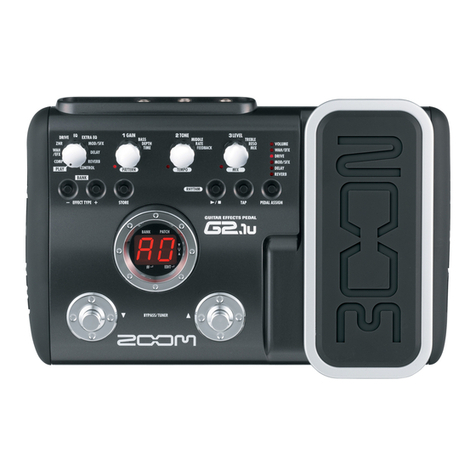
Zoom
Zoom G2.1u User manual
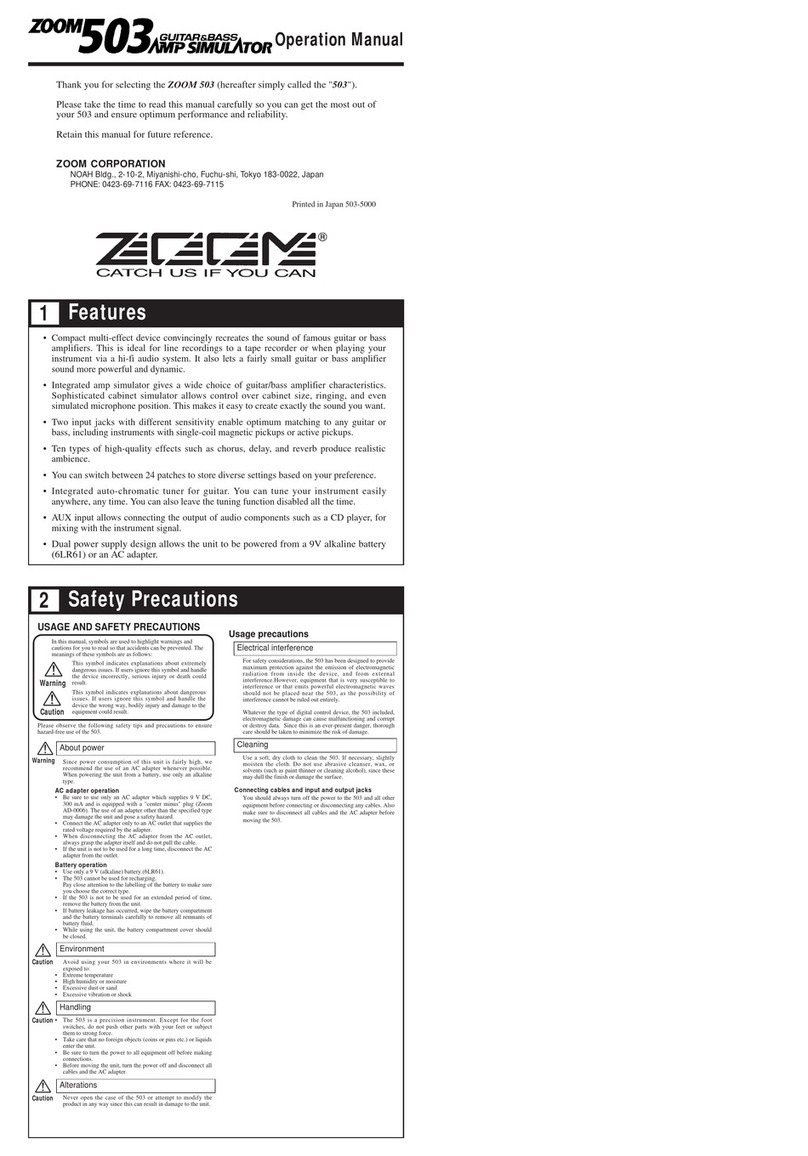
Zoom
Zoom 503 AMP SIMULATOR User manual

Zoom
Zoom MULTISTOMP MS-50G+ User manual
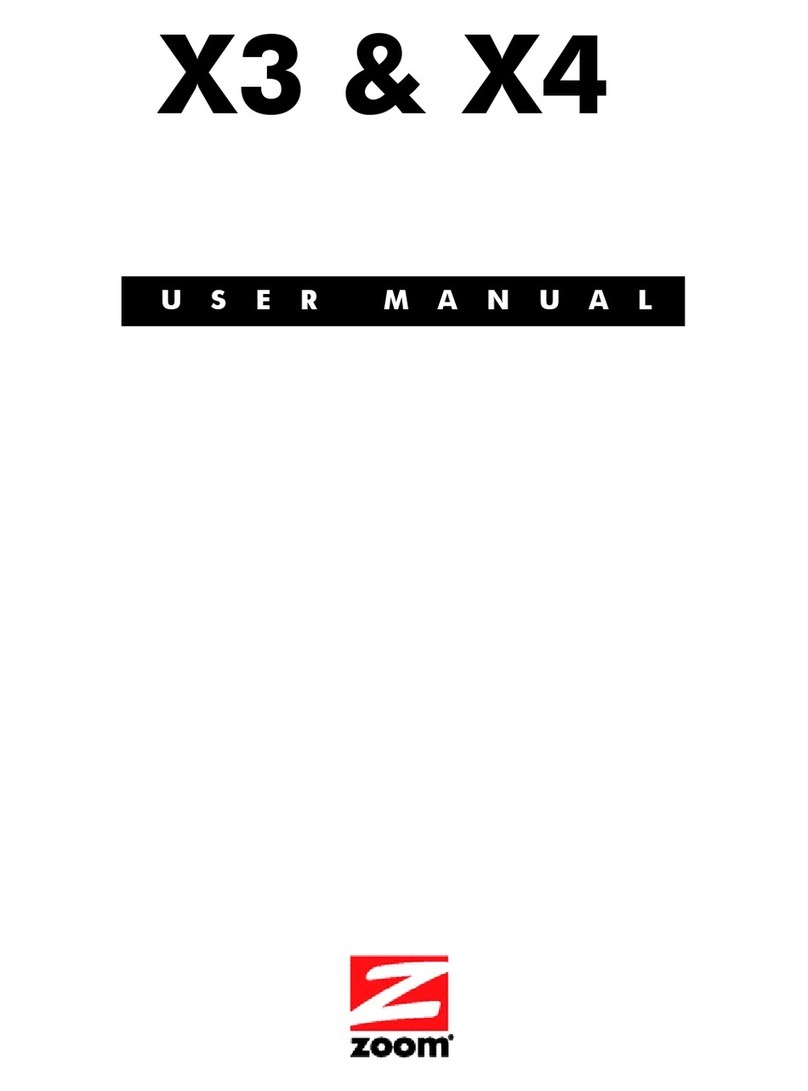
Zoom
Zoom ADSL X3 User manual
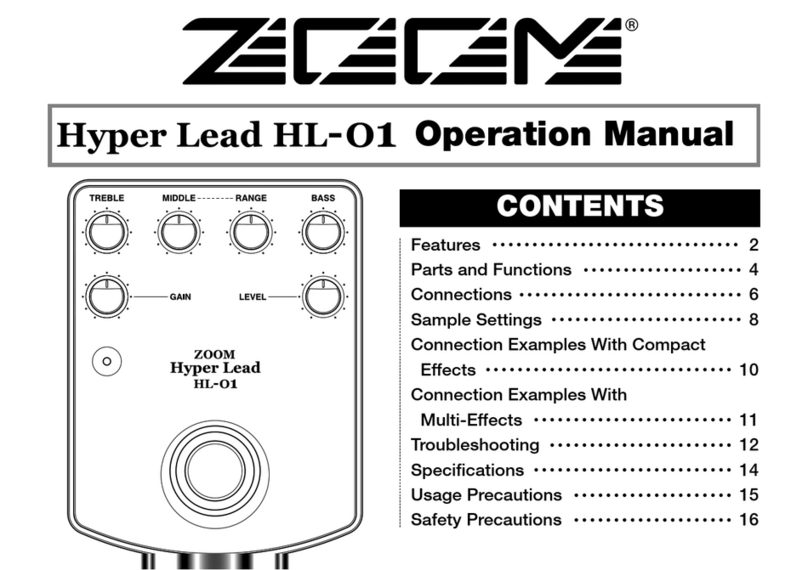
Zoom
Zoom Hyper Lead HL-01 User manual
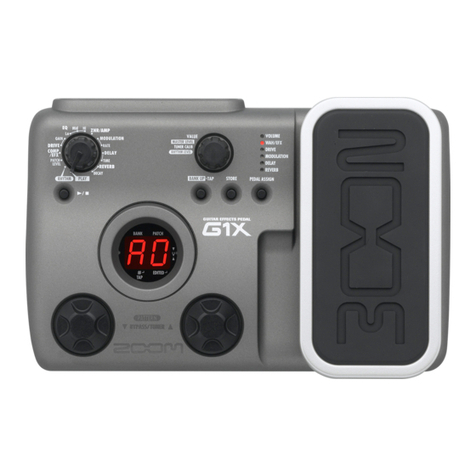
Zoom
Zoom G1 X Four User manual

Zoom
Zoom G1on User manual


